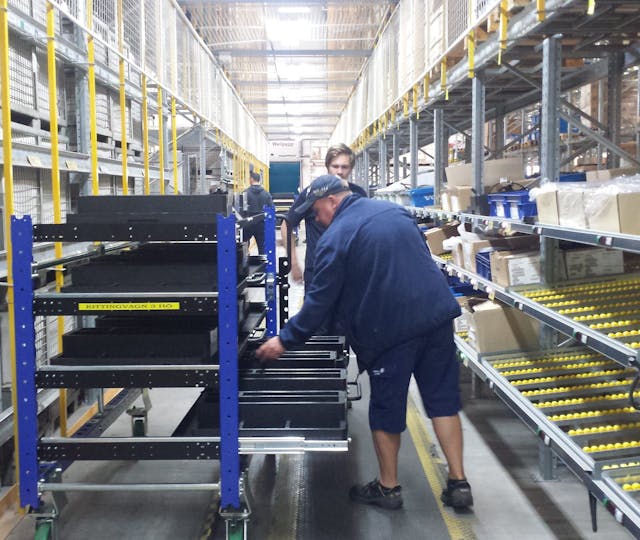Optimizing Warehousing Logistics with Autonomous Mobile Robots

The industrial sector has continuously relied on warehouse facilities to temporarily store goods to fulfill orders.
From the 1st to the 4th industrial revolution an optimized warehouse operation has always led to speedy order fulfillment and optimized production cycle and improved inventory management. This is why some have called the warehouse the lighthouse that directs chaotic industrial processes.
An organized warehouse leads to increased process optimization while disorganization leads to lower service levels. To understand why disorganization affects optimizing activities related to warehousing, knowledge of the functions of a warehouse is required. Warehouses serve as:
- Shipment Hubs – A shipment hub warehouse is where goods and other items are stored and shipped to other locations. The shipment hub is traditionally located in strategic regions which are easily accessed by enterprises that require the goods stored within them.
- Assembly Line – In the manufacturing industry, inventory and other resources are stored in in-house warehouses that can be quickly accessed during a production cycle. The warehouse generally contains manufactured components or assembling tooling which must be assembled or used to assemble a final product.
- Storage Space – The traditional warehouse is a storage space where items are kept until they’re required to assist production or boost the market availability of a particular product.
Shipment hubs warehousing and assembly line warehouses must function optimally to speed up product delivery and production cycles. Thus, the effects of a disorganized warehouse reverberate down the assembly line and result in lower revenues and dissatisfied customers.
To ensure warehousing is optimized, a functional material handling system is required. Material handling refers to the movement of materials within a building or between a building and a vehicle. Thus, the average warehouse relies on material handling systems to ensure kept items are properly transferred when the need arises. In assembly line warehousing, material handling is required to move materials, components, and tools from warehouses to workstations within the manufacturing facility.
Optimizing warehousing in shipment hubs relies on optimized logistics planning and material handling systems also has roles to play. Logistics are the processes involved with transporting finished items or raw materials to the end-user. These items must be moved from a shipment hub to a vehicle before getting to the user. A material handling system is required to move the items from the shipment hub without incurring damages.
Material Transportation within the Warehouse
To ease the material handling process and transportation within the warehouse diverse transportation strategies have been developed over time. These strategies range from milk runs to A to B transportation among others. An outline of the transportation strategies include:
Milk Runs
This transportation process involves the movement of materials or loads from a centralized storage area or warehouse to different sections of a facility. Milk runs are used to service assembly lines and to execute just-in-time delivery.
A to B Runs
This transportation or material handling process involves the movement of load from point A to point B. Manual labor and carts or pallets are generally used to move loads from one point to another.
Points of Presence in the Territory (POPITT)
POPITT refers to warehouse facilities where customers come to pick finished goods or return defective goods. The material transportation system used here is generally manual through carts.
The need for Autonomous Processes within the Warehouse
Logistics in the warehouse involves three major activities which include; order processing, inventory management, and transportation. Order processing is driven by customer requests using order forms. For product sellers such as in an e-commerce shop, order requests are for finished goods while in manufacturing order requests kick-start the production cycle. Inventory management refers to the management of goods waiting to be transported to sales sites or the assembly floor. Transportation involves moving requested materials to specific areas.
The manual processes associated with warehousing and its three activities lead to errors. For example, order forms filled on paper can be lost, and analyzing available inventory written on paper is a time-consuming task prone to error. Thus, embracing industrial automation reduces these errors.
The e-commerce industry has welcomed the use of digital transformation technologies to automate warehouse processes. Technologies such as inventory management software simplify order processing and matching order requests against available inventory. Scheduling and simulation modeling reduces shop floor traffic when handling or transporting materials to enhance safety measures. Despite developing optimized schedules using scheduling and simulation modeling software, errors still occur within the warehouse because humans provide the labor powering the transportation of materials.
Today, the use of a manual material handling system is responsible for thousands of accidents on the shop floor. To eliminate the threat to operator safety, warehouses must consider automating the transportation process using autonomous mobile robots.
Autonomous mobile robots (AMRs) are smart devices that can move through an environment without requiring the assistance of a human operator. The environment, in this case, is the warehouse layout and AMRs are expected to navigate the floor dynamically without having to rely on a fixed pre-determined path or magnetic tracks.
AMRs rely on advanced technologies to navigate the shop floor. These technologies include sensors to track its immediate environment and understand it, loading and unloading gear to automate order pickups, and other smart devices to capture data. AMRs differ from AGVs in diverse ways but the most important difference is their ability to navigate the shop floor without following preset tracks.
AMRs comprehensively automate the in-house logistics and material handling process within warehouse facilities using the aforementioned technologies they’re equipped with. When implemented, AMRs can serve as edge devices that capture data from the warehouse and transfer the captured data to centralized computing platforms for further analysis.
The autonomy AMRs provide means they can be deployed to handle milk runs and other transportation strategies within the warehouse. AMRs can liaise with other digital transformation tools such as the digital twin to implement some Industry 4.0 business models. For example, a risk-based schedule integrates real-time changes such as new deadlines to optimize warehouse operations. AMRs can utilize the new schedule to speed up its just-in-time deliveries to meet the new delivery timeline.

The Benefits of Autonomous Mobile Robots
Utilizing AMRs within the warehouse comes with value-added advantages that lead to increased revenue growth. The more important benefits of automating material handling using autonomous robots in warehousing include:
- Shorter Lead Times – Larger warehouses mean extensive storage space stocked with thousands of inventory. Navigating these complex structures increases lead time for fulfilling orders and is prone to errors as manually navigating large spaces even with a map is challenging. AMRs are equipped with the capacity to analyze data and pinpoint inventory quickly. The speed of operation AMRs bring to the table reduces the lead time for fulfilling bulk orders in large warehouses and reduces the walking times of operators within the warehouse.
- Increased Flexibility – AMRs do not need to be wired to follow set pathways. This means an AMR can find its way despite recent changes to a warehouse layout to accommodate new products. The flexibility autonomy provides means AMRs can be tasked with new activities without having to go through any complex onboarding process.
- Increased Safety – One major reason for deploying AMRs in warehouses is to reduce accidents on the shop floor caused by traffic and the use of heavy lifting equipment such as forklifts. The sensors integrated into AMRs ensure they understand their environment to adjust their speed and avoid collisions in real-time when handling material handling activities. Applying AMRs for repetitive transportation also removes humans from problematic situations which can cause harm.
- Scalability – AMRs can be implemented using modular deployment strategies which can be scaled up to meet expanding operations. The onboarding process does not require the laying of tracks or purchasing multiple tugger carts or robotic equipment which reduces the startup cost for utilizing AMRs. Warehouse managers can simply add new AMRs to an available fleet when scaling up is required.
Conclusion
Autonomous mobile robots provide flexibility to logistics management that traditional material handling solutions cannot match. Deploying an AMR is a move to digitally transform warehousing processes by integrating automation aspects of Industry 4.0.
Reach out to us!
-
U.S.
![]()



